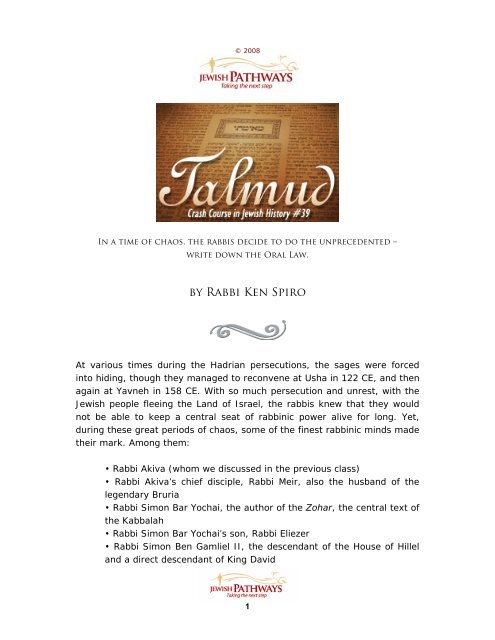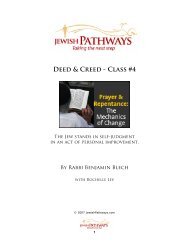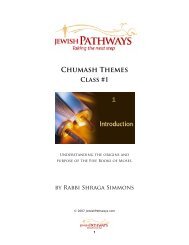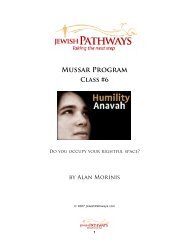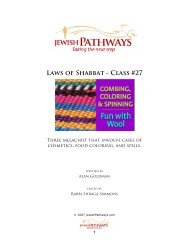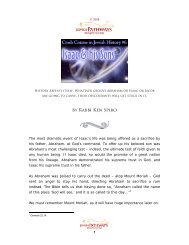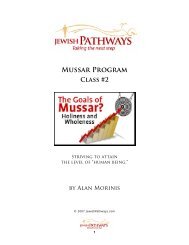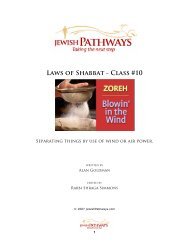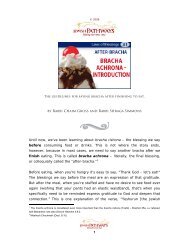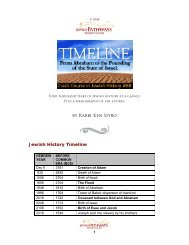The Talmud - Pathways
The Talmud - Pathways
The Talmud - Pathways
You also want an ePaper? Increase the reach of your titles
YUMPU automatically turns print PDFs into web optimized ePapers that Google loves.
© 2008<br />
In a time of chaos, the rabbis decide to do the unprecedented –<br />
write down the Oral Law.<br />
by Rabbi Ken Spiro<br />
At various times during the Hadrian persecutions, the sages were forced<br />
into hiding, though they managed to reconvene at Usha in 122 CE, and then<br />
again at Yavneh in 158 CE. With so much persecution and unrest, with the<br />
Jewish people fleeing the Land of Israel, the rabbis knew that they would<br />
not be able to keep a central seat of rabbinic power alive for long. Yet,<br />
during these great periods of chaos, some of the finest rabbinic minds made<br />
their mark. Among them:<br />
• Rabbi Akiva (whom we discussed in the previous class)<br />
• Rabbi Akiva’s chief disciple, Rabbi Meir, also the husband of the<br />
legendary Bruria<br />
• Rabbi Simon Bar Yochai, the author of the Zohar, the central text of<br />
the Kabbalah<br />
• Rabbi Simon Bar Yochai’s son, Rabbi Eliezer<br />
• Rabbi Simon Ben Gamliel II, the descendant of the House of Hillel<br />
and a direct descendant of King David<br />
1
Judah HaNasi<br />
Now, another man was to emerge and impact the Jewish world in a major<br />
way; he was the son of Rabbi Simon Ben Gamliel II – Rabbi Judah HaNasi<br />
(“Judah, the Prince”).<br />
Rabbi Judah HaNasi is one personality who is absolutely fundamental to<br />
understanding this period of time, and one of the greatest personalities of<br />
Jewish history. So great was he that he is now affectionately referred to in<br />
Jewish scholarship as only the Rebbe.<br />
He had a unique combination of attributes – being both a great Torah<br />
scholar and a strong leader – that gave him the power to lead the Jewish<br />
people at this chaotic time. He was also a man of tremendous personal<br />
wealth, which put him in a position to wheel and deal and do what needed<br />
to get done, not just with the Jews in the Land of Israel but with the Roman<br />
authorities as well.<br />
Hadrian died in 139 CE and with his death came an improvement in the<br />
treatment of the Jewish community in Israel. During a period of relative<br />
quiet, Rabbi Judah HaNasi managed to befriend the Roman emperors who<br />
succeeded Hadrian, particularly Marcus Aurelius. Writes historian Rabbi<br />
Berel Wein:<br />
Providentially, in the course of the Parthian war, Marcus Aurelius met<br />
Rabbi [Judah HaNasi], and they became friends and eventually<br />
confidants. Marcus Aurelius consulted with his friend in Judea on<br />
matters of state policy as well as on personal questions... <strong>The</strong> years<br />
of Marcus Aurelius’ reign, ending in his death in 180 CE, was the<br />
high-water mark in the intercourse between Rome and the Jews. <strong>The</strong><br />
Jews, under the leadership of Rabbi [Jehudah HaNasi] would use this<br />
period of blissful respite to prepare themselves for the struggle of<br />
darker days surely lurking around the corner. 1<br />
At this time – circa 188 CE – the Mishnah was born.<br />
1 Wein, Berel, Echoes of Glory, p. 224. Also see: <strong>Talmud</strong>, Tractate Avodah Zara 10a-b; Midrash, Breishit<br />
Rabbah 67:6; 75:5<br />
2
Mishnah<br />
What is the Mishnah?<br />
In past installments, we discussed the fact that at Mount Sinai the Jewish<br />
people received the Written Torah and the Oral Torah. <strong>The</strong> Oral Torah was<br />
the oral explanation of how the written laws should be executed and<br />
followed.<br />
<strong>The</strong> Oral Torah passed from generation to generation and was never written<br />
down. 2 Why? Because the Oral Torah was meant to be fluid. <strong>The</strong> principles<br />
stayed the same, but the application of those principles was meant to be<br />
adapted to all types of new circumstances.<br />
This worked exceptionally well as long as the central authority – the<br />
Sanhedrin – remained intact, and the chain of transmission was not<br />
interrupted. (That is, teachers were able to freely pass on their wisdom to<br />
the next generation of students.) But in the days since the destruction of<br />
the Temple, the Sanhedrin had been repeatedly uprooted and teachers had<br />
to go into hiding.<br />
Rabbi Judah HaNasi realized that things<br />
would not get better any time soon. He<br />
saw that the Temple would not be rebuilt<br />
in his generation and possibly in many<br />
generations to come. He saw the Jews<br />
fleeing the land as a result of the constant<br />
persecutions and impossible living<br />
conditions. He saw that the central<br />
authority was weaker than ever and might<br />
cease altogether. To make sure that the chain of transmission would never<br />
be broken, he decided that the time had come to write down the Oral<br />
Torah. 3<br />
2 Midrash, Tanchumah Ki Tisa 34; <strong>Talmud</strong>, Tractate Gittin 60a.<br />
3 For a detailed explanation of actions of Rabbi Judah HaNasi see Maimonides, Mishneh Torah<br />
Introduction. See also Iggerot d’Rabbi Sheriram Gaon 1:1.<br />
3
This was a mammoth undertaking. Although much of the work may have<br />
already been done by previous generations of rabbis, the monumental task<br />
of editing, explaining and organizing this vast amount of material was left to<br />
Rabbi Judah. <strong>The</strong> end result of this massive undertaking was a definitive,<br />
yet cryptic (the basic principles were all there, yet a teacher was still<br />
required to elucidate the material) version of the entire Oral Law called the<br />
Mishnah. (Incidentally, the word Mishnah means “repetition” because it was<br />
studied by repeating – Mishnah then, by extension, means “learning.”)<br />
Maimonides, in the introduction to his Mishneh Torah, explains it as follows:<br />
He gathered together all the traditions, enactments, interpretations<br />
and expositions of every position of the Torah, that either came down<br />
from Moses, our teacher, or had been deduced by the courts in<br />
successive generations. All this material he redacted in the Mishnah,<br />
which was diligently taught in public, and thus became universally<br />
known among the Jewish people. Copies of it were made and widely<br />
disseminated, so that the Oral Law might not be forgotten in Israel.<br />
<strong>The</strong> Mishnah, which is written in Hebrew, is divided into six basic segments<br />
or “orders” and further subdivided into 63 tractates with a total of 525<br />
chapters. <strong>The</strong> six segments deal with six basic areas of Jewish law:<br />
• Zeraim, literally “seeds,” covering all agricultural rules and laws for<br />
foods as well as all blessings<br />
• Moed, literally, “holiday,” dealing with the rituals of Shabbat and<br />
other Jewish holidays<br />
• Nashim, literally “women,” examining all the issues between men<br />
and women such as marriage, divorce, etc.<br />
• Nezikin, literally “damages,” covering civil and criminal law<br />
• Kodshim, literally “holy things,” concerning laws of the Temple<br />
• Taharot, literally “pure things,” concerning laws of spiritual purity<br />
and impurity<br />
Rabbi Judah HaNasi finished the Mishnah in 190 CE in the town of Tzipori in<br />
the Galilee. You can visit the site today, and the area is very interesting<br />
from an archeological perspective. At a site called Beit She’arim (where the<br />
Sanhedrin had previously been located prior to its move to Tzipori), there is<br />
4
a vast number of burial caves carved into the side of a mountain. Based on<br />
evidence found at the site, archaeologists believe that one of these caves<br />
contains the grave of Rabbi Judah HaNasi, along with many other great<br />
scholars of that time.<br />
Writing the <strong>Talmud</strong><br />
During the centuries following the completion of the Mishnah, the chain of<br />
transmission of the Oral law was further weakened by a number of factors.<br />
Economic hardship and increased persecution of the Jewish community in<br />
Israel caused many Jews, including many rabbis, to flee the country. Many<br />
of these rabbis emigrated to the Babylon region (today’s Iraq) of the<br />
Persian Empire.<br />
As a result, the role of the rabbis of Israel as the sole central authority of<br />
the Jewish people came to an end. This decentralization of Torah authority<br />
and lack of consensus among the rabbis led to further weakening of the<br />
transmission process. Thus it became clear to the sages of this period that<br />
the Mishnah alone was no longer clear enough to fully explain the Oral Law.<br />
It was written in shorthand fashion and in places was cryptic. This is<br />
because it was very concise, written on the assumption that the person<br />
reading it was already well-acquainted with the subject matter. So the<br />
rabbis began to have discussions about it and to write down the substance<br />
of these discussions.<br />
Since at this time a significant portion of the Jewish population was living in<br />
Babylon, which was outside the bounds of the Roman Empire, the rabbis<br />
there put together their discussions, the end product of which was called<br />
<strong>Talmud</strong> Bavli or the Babylonian <strong>Talmud</strong>. Even before this process had begun<br />
in Babylon, another set of discussions took place in the Land of Israel, and<br />
the end result was <strong>Talmud</strong> Yerushalmi or the Jerusalem <strong>Talmud</strong>.<br />
(Incidentally, the Jerusalem <strong>Talmud</strong> was not written in Jerusalem; it was<br />
written in Tiberias, the last place where the Sanhedrin sat, but was called<br />
the Jerusalem <strong>Talmud</strong> in deference to the Sanhedrin’s rightful home.)<br />
5
Due to persecution of the Jewish community in Israel, the Jerusalem<br />
<strong>Talmud</strong>, completed in the mid 4 th century CE, was never fully edited. <strong>The</strong><br />
Jerusalem <strong>Talmud</strong> is much shorter (it contains only four of the six sections<br />
of the Mishnah) and is harder to understand than the Babylonian <strong>Talmud</strong>.<br />
<strong>The</strong> situation of the Jews in Babylon was much more stable and the rabbis<br />
there had considerably more time to edit and explain the subject matter.<br />
Although there are two <strong>Talmud</strong>s, they are not really separate. <strong>The</strong> rabbis of<br />
Babylon had access to the Jerusalem <strong>Talmud</strong> while they were working on<br />
their text. But in case of a dispute, the Babylonian <strong>Talmud</strong> is followed. 4<br />
Because the Babylonian <strong>Talmud</strong> is considered more authoritative and the<br />
Jerusalem <strong>Talmud</strong> is more difficult to study, Jewish students pouring over<br />
the <strong>Talmud</strong> in yeshivas today are using chiefly the Babylonian <strong>Talmud</strong>.<br />
<strong>The</strong> <strong>Talmud</strong> is more than just an application of the details of the Jewish law<br />
as expounded in the Mishnah. It’s the encyclopedia of all Jewish existence.<br />
<strong>The</strong> <strong>Talmud</strong> also contains a lot of Agadata – stories that are meant to<br />
illustrate important points in the Jewish worldview. <strong>The</strong>se stories contain a<br />
wealth of information on a huge range of topics. You name it, it’s in there.<br />
This information has always been vital to the Jewish people because Jewish<br />
law was never applied by reading a sentence in the Torah and executing it<br />
to the letter. Take for example, “an eye for an eye, a tooth for a tooth.” It<br />
was never Jewish law that if someone blinded you, that you should go and<br />
blind him. What is the good of having two blind people? It was always<br />
understood on two levels: 1) that justice must be proportional (it’s not a life<br />
for an eye), and 2) that it means the value of an eye for the value of the<br />
eye, referring to monetary damages. Thus, the <strong>Talmud</strong> presented the<br />
written and oral traditions together.<br />
To read the <strong>Talmud</strong> is to read a lot of arguments. On every page it seems<br />
that the rabbis are arguing. This kind of argument – the purpose of which<br />
was to arrive at the kernel of truth – is called pilpul. This word has a<br />
negative connotation outside the yeshiva world, as people read these<br />
4 HaRif on <strong>Talmud</strong>, Tractate Eruvin 35b.<br />
6
arguments and it seems to the uneducated eye that the rabbis are merely<br />
splitting hairs, and that some of the arguments have absolutely no basis in<br />
everyday life. But this is not so.<br />
<strong>The</strong> reason why the rabbis argued about things that may not have any<br />
application to everyday life was to try to get to truth in an abstract way – to<br />
understand the logic and to extract the principle. <strong>The</strong>se rabbis were<br />
interested in understanding reality and in doing the right thing. Reality is<br />
what Judaism is all about – the ultimate reality being God.<br />
Another important point is that much of the dispute is focused on relatively<br />
minor points while the larger issues were generally not disputed. You don’t<br />
see a single argument as to whether or not you can eat pork, or whether or<br />
not you can light a fire on Shabbat. <strong>The</strong>se things were given, they were<br />
totally agreed upon. Only small points were subject to discussion. And these<br />
rabbis were wise enough to know that a day would come when the<br />
principles established by getting to the kernel of truth would have far<br />
reaching implications.<br />
Gemara<br />
When you look at the page of the<br />
Babylonian <strong>Talmud</strong> today, you will find the<br />
Hebrew text of the Mishnah is featured in<br />
the middle of the page. Interspersed<br />
between the Hebrew of the Mishnah are<br />
explanations in both Hebrew and Aramaic<br />
which are called the Gemara.<br />
<strong>The</strong> Aramaic word Gemara means “tradition.” In Hebrew, the word Gemara<br />
means “completion.” Indeed, the Gemara is a compilation of the various<br />
rabbinic discussions on the Mishnah, and as such completes the<br />
understanding of the Mishnah.<br />
<strong>The</strong> texts of the Mishnah and Gemara are then surrounded by other layers<br />
of text and commentaries from a later period.<br />
7
<strong>The</strong> text of the Mishnah is quoting rabbis who lived circa 100 BCE to 200<br />
CE. <strong>The</strong>se rabbis are called the Tana’im, or “teachers.” In this group are<br />
included such greats as Rabbi Johanan Ben Zakkai, Rabbi Simon Bar Yochai,<br />
Rabbi Akiva, and of course Rabbi Judah HaNasi. (In the Gemara, they<br />
usually have the title Rebbe before their first name although there are many<br />
exceptions such as the names: Hillel, Shamai, Ben Azai and Ben Zoma.)<br />
<strong>The</strong> text of the Gemara is quoting the rabbis who lived circa 200 CE to<br />
about 500 CE. <strong>The</strong>se rabbis are called, Amora’im, “explainers” or<br />
“interpreters.” In this group are included Rav Huna, Rav Ashi, etc. (Names<br />
of the Babylonian Amora’im are usually preceded by the title Rav as<br />
opposed to the Israeli Amora’im who continued to use the title<br />
Rabbi/Rebbe. This is because the authentic institution of rabbinic ordination<br />
was only done in the Land of Israel.)<br />
PERIOD CIRCA CHAIN OF TRANSMISSION<br />
Moses<br />
Mount Sinai 1312 BCE Joshua<br />
<strong>The</strong> Elders<br />
1260 BCE -<br />
800 BCE<br />
<strong>The</strong><br />
800 BCE –<br />
Prophets 5 410 BCE<br />
<strong>The</strong> Great<br />
Assembly<br />
Zugot<br />
Pinhas and the 70 Elders<br />
Eli<br />
Samuel<br />
King David<br />
King Solomon<br />
Ahijah<br />
Elijah<br />
Elisha<br />
Jehoiada<br />
Zechariah<br />
Hosea<br />
Amos<br />
Isaiah<br />
Micah<br />
Joel<br />
Nahum<br />
Habakuk<br />
Zephaniah<br />
Jeremiah<br />
Baruch<br />
410 BCE – 120 Men of the Great Assembly<br />
312 BCE Simon HaTzaddik, last remnant<br />
Jose Ben Joezer and Jose Ben Johanan<br />
Jehoshua Ben Perahiah and Nittai of Arbel<br />
260 BCE – Judah Ben Tabbai and Simon Ben Shatach<br />
5 Of course, Moses and Joshua were also prophets, as were many of those that came before this time<br />
period and after it, however the period is named after the figures that dominated it.<br />
8
(“Pairs”)<br />
Tana’im<br />
(“Teachers”)<br />
Amora’im<br />
(“Explainers”)<br />
10 CE<br />
10 CE –<br />
200 CE<br />
200 CE –<br />
500 CE<br />
Shemaiah and Avtalion<br />
Hillel and Shammai<br />
R’Simon Ben Hillel, R’Johanan Ben Zakkai<br />
Rabban Gamliel the Elder, R’Eliezer Ben<br />
Hyrcanus, R’Jehoshua ben Hananiah,<br />
R’Simon Ben Netanel, R’Elazar Ben Arakh<br />
Rabban Simon Ben Gamliel I, R’Akiva,<br />
R’Tarfon, R’Simon Ben Elazar, R’Johanan Ben<br />
Nuri<br />
Rabban Gamliel II, Rebbe Meir, Rebbe<br />
Ishmael, Rebbe Judah, Rebbe Jose, R’Simon<br />
Bar Yochai<br />
R’Simon Ben Gamliel II<br />
R’Judah HaNasi (codifier of the Mishnah)<br />
Rav Samuel, Rabbi Johanan (compiler of<br />
Jerusalem <strong>Talmud</strong>)<br />
Rav Huna, Rav Judah, Rav Nachman, Rav<br />
Kahana, Rabba Bar Hanna, Rav Ami, Rav Asi<br />
Rabbah, Rav Josef, Rav Hisda, Rabba Bar<br />
Huna<br />
Abaja, Rava<br />
Rav Ashi and Ravina (compilers of the<br />
Babylonian <strong>Talmud</strong>)<br />
<strong>The</strong> surrounding text of today’s <strong>Talmud</strong> also quotes Rishonim, literally “the<br />
first ones,” rabbinic authorities (circa 1000 CE to 1500 CE) who predated<br />
Rabbi Joseph Caro, the 16 th century author of the Code of Jewish law known<br />
as the Shulchan Aruch. Among the most prominent Rishonim are: the 11 th<br />
century commentator Rashi, his students and descendants who were the<br />
chief authors of the commentary called Tosfot, and the 12 th century<br />
philosophers Maimonides and Nachmanides. We will discuss the<br />
contributions of these rabbis in classes 44 and 47.<br />
Just how important was the work of Rabbi Judah HaNasi and those that<br />
followed him would become very clear in the next 200 years when the<br />
Jewish people would face another threat to their religion. This is when the<br />
Roman Empire decided to convert its entire population to Christianity.<br />
9


